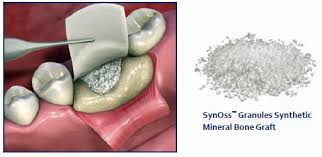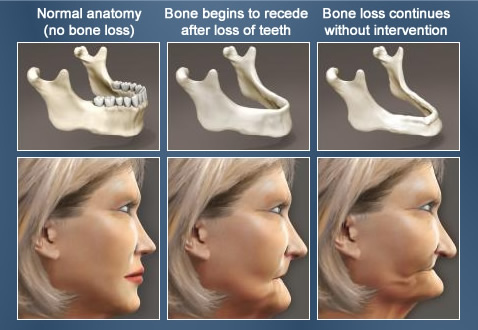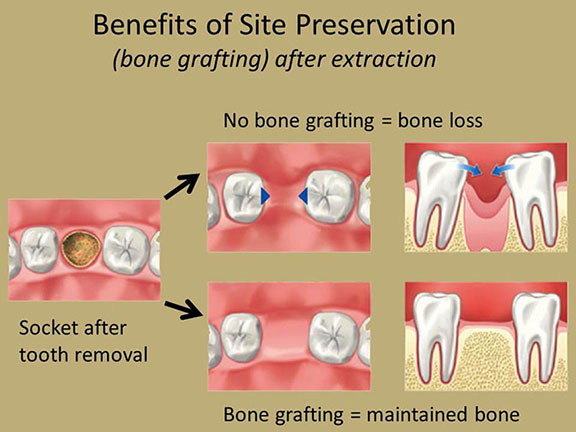Bone grafting is the most effective way to preserve your jaw bone and keep your jawline after you have lost a tooth or teeth.
bone_graft
When a person breaks a bone in his body, it will naturally repair by itself. But this is not the case with the jawbone. When you lose a tooth, the site of extraction partially refills with bone. However, over time, the bone material in this area will deteriorate and shrink. Studies show that there’s a 40 to 60% bone loss within 2-3 years from the time of tooth extraction/loss. And that’s not all. Neighboring teeth will also be affected, resulting in a receding jawline. When this happens, your otherwise healthy teeth can become loose or may move. Gum pockets may also develop. You’ll experience difficulty in chewing, your bite will collapse and your facial lines will change, making you look older.
bone_graft
Your dentist can perform a procedure called advance extraction therapy, which is a fast, painless and straightforward procedure that can be done right after tooth extraction. Bone grafting, which we offer in our Fort Myers office, is one of the most trusted extraction therapy procedures and the patented synthetic bone material is very effective in stimulating bone regeneration.
bone_graft
What your dentist will do is fill the socket (where your tooth used to be) with a bone graft material which functions as a scaffold that stimulates bone growth, enabling the bone to return to its original width and height.
Using synthetic bone material is not a cause for concern because your own bone will grow through and around it, so that the original bone ridge is restored. This is vital in providing a solid base for other treatments like a dental bridge or implant, which are needed to restore function and improve the esthetics of your teeth.
bone_graft Bone grafting is also used as a treatment for patients with advance cases of periodontal disease. The disease can damage the bone supporting the teeth and bone grafting can reverse some of the damage.
The success rate of bone grafting is 97.9% as reported by more than 60 dentists who have performed this procedure. Facts About Dental Bone Grafting Did you ever think a dentist might suggest that you have a bone graft performed as part of a standard tooth replacement procedure? Believe it or not, it's now a routine treatment — and it's not as complicated as you may think. Welcome to 21st Century dentistry!
If you're thinking about getting a tooth implant — an attractive, strong and long-lasting option for tooth replacement — here are four things you should know about bone grafting.
A bone graft may be needed prior to placing a dental implant.
One major reason why dental implants work so well as replacements for natural teeth is that they actually become fused to the underlying bone. This system offers superior durability, and a host of other advantages. Unfortunately, when a tooth is lost, the surrounding bone often begins to disappear (resorb) as well. In that case, it may be necessary to rebuild some of the bone structure before an implant can be placed effectively.
Bone regeneration for tooth implants is a routine procedure. When it's needed, bone grafting has become a standard practice in periodontal and oral surgery. It is often performed prior to (or, occasionally, at the same time as) placing a dental implant. The grafting procedure itself can be done in the office, using local anesthesia (numbing shots, like those used for a filling) or conscious sedation (“twilight sleep”) to relieve anxiety.
The process may use a variety of high-tech materials.
The small amount of bone grafting material you need may come from a variety of sources, including human, animal or synthetic materials. Before it is used, all grafting material is processed to make it completely safe. In addition to the grafting material itself, special “guided bone regeneration” membranes and other biologically active substances may be used to promote and enhance healing.
Bone regeneration lets your body rebuild itself.
Your body uses most bone grafting materials as a scaffold or frame, over which it is able to grow its own new bone tissue. In time, the natural process of bone regeneration replaces the graft material with new bone. As we now know, maintaining sufficient bone tissue around the teeth is a crucial part of keeping up your oral health. That's why today when a tooth is going to be extracted (removed), often a bone graft will be placed at the time of extraction to preserve as much bone as possible.
Are you considering dental implants for tooth replacement, and wondering whether you may need bone grafting? Come in and talk to us! With our up-to-date training and clinical experience, we can answer your questions, and present the treatment options that are best in your individual situation. F





bone Grafting
If you think you can benefit from a bone grafting procedure, please call our office at (239) 939-7070 to schedule an appointment with our dentists.
